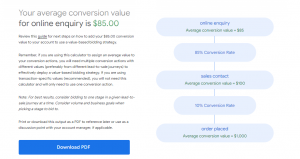With the increasing use of automated bid strategies in Google Ads and the focus on conversion value or ROAS (Return On Advertising Spend) it’s important to apply conversion values to your goals, even if they are not directly leading to a sale. In addition to this, if you’re tracking different goal types, you should apply values to each of these to identify the more important actions that your site visitors may take. We’re often asked what values to apply, and Google has provided a useful tool to help with this calculation.
Since the main bid strategies in Google Ads now bid towards conversion value, this can be an effective way to reach your most valuable customers and maximize ROI (Return on Investment). Generating leads may involve measuring various types of conversion, possibly with on-and-offline events in your conversion funnel, so this can make it difficult to know which are the best actions to optimise for, unless they all have different values applied.
If you’re not tracking direct sales with an attached revenue value, you will probably have some conversions that are worth more to your business than others – such as users completing an enquiry form compared to those who click a phone link to call your business. In these situations, mapping out your lead-to-sale journey can help you identify the key stages in your funnel and determine the average values of your conversion actions, so that you can then effectively use a value-based bidding strategy in Google Ads.
You therefore need to look at your known business data over the last 6-12 months and consider the paths that customers have taken from an initial contact point. You should collect data in the different contact channels that are used and the conversion rate between each stage of the enquiry to conversion process. If you then know the average revenue value for an eventual sale, you can calculate this back to the original contact point based on the conversion stages.
Google has provided an online calculator to enter your known or estimated figures, and to generate the average conversion value for each type of enquiry, based on the stages of the conversion process, the conversion rates for each stage, and the eventual average order value. You can then set that figure as the target of your bid strategy, or use it as the target figures to assess your Google Ads performance and make changes where you’re not achieving that target metric.

It may take a bit of effort to get the relevant numbers together, and you might also want to get different people in your organisation to work through the figures to see what results are generated. However, this should be basic business knowledge using your records of enquiries and conversions to sales, which is ultimately the primary objective. You may also need to review your figures every 6 to 12 months to check they are still relevant for your business performance and bid strategy in your Google Ads campaigns.
If you want to know more about calculating your conversion values and maxmising your bid strategy in Google Ads, please get in touch and we can advise you on the best approach. We have been experts in Google Ads / AdWords advertising since 2002 and can use our experience to help your advertising get the best possible results.
